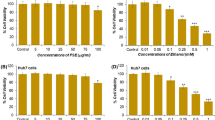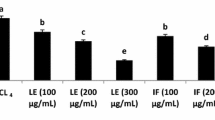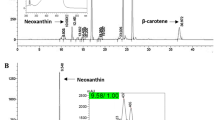Abstract
A number of liver diseases are known to be caused by oxidative stress. Petroselinum sativum (P. sativum; parsley) is popular for its anti-inflammatory, antimicrobial, anticancer, antioxidant and antidiabetic activities. However, till date the hepatoprotective potential of chloroform extract of P. sativum (PSA) on hydrogen peroxide (H2O2) induced cytotoxicity and oxidative stress in human liver (HepG2) cells have not been studied. Therefore, this study was framed to evaluate whether the levels of hydrogen peroxide (H2O2) induced cytotoxicity and oxidative stress in HepG2 cells could be diminished by pretreating the cells with PSA. MTT assay, NRU assay, morphological alterations, glutathione (GSH) depletion, lipid peroxidation (LPO), ROS generation and loss of mitochondrial membrane potential (MMP) were assessed by using non-cytotoxic concentrations (5, 10 and 25 μg/mL) of PSA against H2O2 (0.25 mM) induced damage in HepG2 cells. The results demonstrated that pretreatment of HepG2 cells with PSA offered protective properties by lowering the LPO and ROS generation and elevating the cell viability, GSH and MMP levels. Together, these results suggest that PSA has the hepatoprotective effect on H2O2 induced cell death in HepG2 cells.








Similar content being viewed by others
References:s
Guan YS, He Q (2015) Plants consumption and liver health. Evid Complement Altern Med 824185:1–10
Madrigal-Santillán E, Madrigal-Bujaidar E, Álvarez-González I, Sumaya-Martínez MT, Gutiérrez-Salinas J, Bautista M, Morales-González Á, y González-Rubio MG, Aguilar-Faisal JL, Morales-González JA (2014) Review of natural products with hepatoprotective effects. World J Gastroenterol 20:14787–14804
Gu X, Manautou JE (2012) Molecular mechanisms underlying chemical liver injury. Expert Rev Mol Med 14:e4
Akinloye OA, Olaniyi MO (2011) Hepato-protective effect of Cajanus cajan on tissue defense system in D-galactosamine-induced hepatitis in rats. Turk J Biochem 36:237–241
Wang FS, Fan JG, Zhang Z, Gao B, Wang HY (2014) The global burden of liver disease: the major impact of China. Hepatology 60:2099–2108
Okaiyeto K, Nwodo UU, Mabinya LV, Okoh AI (2018) A review on some medicinal plants with hepatoprotective effects. Pharmacogn Rev 12:186–199
Sathesh KS, Ravi KB, Krishna MG (2009) Hepatoprotective effect of Trichosanthes cucumerina var cucumerina L. on carbon tetrachloride induced liver damage in rats. J Ethnopharmacol 123:347–350
Ajboye TO, Yakubu MT, Salau AK, Oladiji AT, Akanji MA, Okogun JI (2010) Antioxidant and drug detoxification potential of aqueous extract of Annona senegalensis leaves in carbon tetrachloride-induced hepatocellular damage. Pharm Biol 48:1361–1370
Partap S, Tewari U, Sharma K, Jha KK (2014) Hepatoprotective activity of whole plant extract of Leptadenia pyrotechnica against paracetamol induced damage in rats. J Drug Deliv 4:36–39
Castán A, Navarro Y, Sarría L, Larrosa R, Serradilla M, Serrablo A (2017) Radiological diagnosis of hepatocellular carcinoma in non-cirrhotic patients. Hepatoma Res 3:1–17
Dutta S, Chakraborty AK, Dey P, Kar P, Guha P, Sen S, Kumar A, Sen A, Chaudhuri TK (2018) Amelioration of CCl4 induced liver injury in swiss albino mice by antioxidant rich leaf extract of Croton bonplandianus Baill. PLoS ONE 13:e0196411
Phaniendra A, Jestadi DB, Periyasamy L (2015) Free radicals: properties, sources, targets, and their implication in various diseases. Indian J Clin Biochem 30:11–26
Pandit A, Sachdeva T, Bafna P (2012) Drug-induced hepatotoxicity: a review. J Appl Pharm Sci 2:233–243
Dogan A, Dalar A, Sadullahoglu C, Battal A, Uzun Y, Celik I, Demirel K (2018) Investigation of the protective effects of horse mushroom (Agaricus arvensis Schaeff.) against carbon tetrachloride-induced oxidative stress in rats. Mol Biol Rep 45:787–797
Siddiqui MA, Ali Z, Chittiboyina AG, Khan IA (2018) Hepatoprotective effect of steroidal glycosides from dioscorea villosa on hydrogen peroxide-induced hepatotoxicity in HepG2 cells. Front Pharmacol 9:797
El-Sayed AE, Aboulthana WM, El-Feky AM, Ibrahim NE, Seif MM (2018) Bio and phyto-chemical effect of Amphora coffeaeformis extract against hepatic injury induced by paracetamol in rats. Mol Biol Rep 45:2007–2023
Bae WY, Kim HY, Park EH, Kim KT, Paik HD (2019) Improved in vitro antioxidant properties and hepatoprotective effects of a fermented Inula britannica extract on ethanol-damaged HepG2 cells. Mol Biol Rep 46:6053–6063
Ajiboye TO, Ahmad FM, Daisi AO, Yahaya AA, Ibitoye OB, Muritala HF, Sunmonu TO (2017) Hepatoprotective potential of Phyllanthus muellarianus leaf extract: studies on hepatic, oxidative stress and inflammatory biomarkers. Pharm Biol 55:1662–1670
Alam J, Mujahid M, Badruddeen JY, Bagga P, Rahman MA (2017) Hepatoprotective potential of ethanolic extract of Aquilaria agallocha leaves against paracetamol induced hepatotoxicity in SD rats. J Tradit Complement Med 7:9–13
Meera R, Devi P, Kameswari B, Madhumitha B, Merlin NJ (2009) Antioxidant and hepatoprotective activities of Ocimum basilicum linn. and Trigonella foenum-graecum linn. against H2O2 and CCL4 induced hepatotoxicity in goat liver. Indian J Exp Biol 47:584–590
Rahim SM, Taha EM, Al-janabi MS, Al-douri BI, Simon KD, Mazlan AG (2014) Hepatoprotective effect of Cymbopogon citratus aqueous extract against hydrogen peroxide-induced liver injury in male rats. Afr J Tradit Complement Altern Med 11:447–451
Ghaffari H, Ghassam BJ, Prakash HS (2012) Hepatoprotective and cytoprotective properties of Hyptis suaveolens against oxidative stress–induced damage by CCl4 and H2O2. Asian Pac J Trop Med 5:868–874
Al-Sheddi ES, Farshori NN, Al-Oqail MM, Musarrat J, Al-Khedhairy AA, Siddiqui MA (2016) Protective effect of Lepidium sativum seed extract against hydrogen peroxide-induced cytotoxicity and oxidative stress in human liver cells (HepG2). Pharm Biol 54:314–321
Kreydiyyeh SI, Usta J, Kaouk I, Al-Sadi R (2001) The mechanism underlying the laxative properties of parsley extract. Phytomedicine 8:382–388
Yanardağ R, Bolkent Ş, Tabakoğlu-Oğuz A, Özsoy-Saçan Ö (2003) Effects of Petroselinum crispum extract on pancreatic B cells and blood glucose of streptozotocin-induced diabetic rats. Biol Pharm Bull 26:1206–1210
Ahmed NZ, El-Deib KM, Ahmed MM (2010) Studies on curcuma longa, chicorium intybus and Petroselinum sativum water extracts against cisplatin-induced toxicity in rats. J Am Sci 6:545–558
Wahba NM, Ahmed AS, Ebraheim ZZ (2010) Antimicrobial effects of pepper, parsley, and dill and their roles in the microbiological quality enhancement of traditional Egyptian Kareish cheese. Foodborne Pathog Dis 7:411–418
Farshori NN, Al-Sheddi ES, Al-Oqail MM, Musarrat J, Al-Khedhairy AA, Siddiqui MA (2013) Anticancer activity of Petroselinum sativum seed extracts on MCF-7 human breast cancer cells. Asian Pac J Cancer Prev 14:5719–5723
Siddiqui MA, Singh G, Kashyap MP, Khanna VK, Yadav S, Chandra D, Pant AB (2008) Influence of cytotoxic doses of 4-hydroxynonenal on selected neurotransmitter receptors in PC-12 cells. Toxicol In Vitro 22:1681–1688
Siddiqui MA, Kashyap MP, Kumar V, Al-Khedhairy AA, Musarrat J, Pant AB (2010) Protective potential of trans-resveratrol against 4-hydroxynonenal induced damage in PC12 cells. Toxicol In Vitro 24:1592–1598
Chandra D, Ramana KV, Wang L, Christensen BN, Bhatnagar A, Srivastava SK (2002) Inhibition of fiber cell globulization and hyperglycemiainduced lens opacification by aminopeptidase inhibitor bestatin. Invest Ophthalmol Vis Sci 43:2285–2292
Buege JA, Aust SD (1978) Microsomal lipid peroxidation. Methods Enzymol 52:302–310
Siddiqui MA, Ahmad J, Farshori NN, Saquib Q, Jahan S, Kashyap MP, Ahamed M, Musarrat J, Al-Khedhairy AA (2013) Rotenone-induced oxidative stress and apoptosis in human liver HepG2 cells. Mol Cell Biochem 384:59–69
Zhang Y, Jiang L, Jiang L, Geng C, Li L, Shao J, Zhong L (2011) Possible involvement of oxidative stress in potassium bromate-induced genotoxicity in human HepG2 cells. Chem Biol Interact 189:186–191
Jiang J, Yu S, Jiang Z, Liang C, Yu W, Li J, Du X, Wang H, Gao X, Wang X (2014) N-acetyl-serotonin protects HepG2 cells from oxidative stress injury induced by hydrogen peroxide. Oxid Med Cell Long 310504:1–15
Sattayasai J, Chaonapan P, Arkaravichie T, Soi-ampornkul R, Junnu S, Charoensilp P, Samer J, Jantaravinid J, Masaratana P, Suktitipat B, Manissorn J (2013) Protective effects of Mangosteen extract on H2O2-induced cytotoxicity in SK-NSH cells and scopolamine-induced memory impairment in mice. PLoS ONE 8:e85053
Pareek A, Godavarthi A, Issarani R, Nagori BP (2013) Antioxidant and hepatoprotective activity of Fagonia schweinfurthii (Hadidi) Hadidi extract in carbon tetrachloride induced hepatotoxicity in HepG2 cell line and rats. J Ethnopharmacol 150:973–981
Krithika R, Mohankumar R, Verma RJ, Shrivastav PS, Mohamad IL, Gunasekaran P, Narasimhan S (2009) Isolation, characterization and antioxidative effect of phyllanthin against CCl4-induced toxicity in HepG2 cell line. Chem Biol Interact 181:351–358
Joshi BC, Prakash A, Kalia AN (2015) Hepatoprotective potential of antioxidant potent fraction from Urtica dioica Linn. (whole plant) in CCl4 challenged rats. Toxicol Rep 2:1101–1110
Farshori NN, Al-Sheddi ES, Al-Oqail MM, Hassan WH, Al-Khedhairy AA, Musarrat J, Siddiqui MA (2015) Hepatoprotective potential of Lavandula coronopifolia extracts against ethanol induced oxidative stress-mediated cytotoxicity in HepG2 cells. Toxicol Ind Health 8:727–737
Hiraganahalli BD, Chinampudur VC, Dethe S, Mundkinajeddu D, Pandre MK, Balachandran J, Agarwal A (2012) Hepatoprotective and antioxidant activity of standardized herbal extracts. Phcog Mag 8:116–123
Rashid U, Khan MR, Sajid M (2016) Hepatoprotective potential of Fagonia Olivieri DC against acetaminophen induced toxicity in rat. BMC Complement Altern Med 16:449
Xia T, Yao J, Zhang J, Zheng Y, Song J, Wang M (2017) Protective effects of Shanxi aged vinegar against hydrogen peroxide-induced oxidative damage in LO2 cells through Nrf2-mediated antioxidant responses. RSC Adv 7:17377–17386
Wahid A, Hamed AN, Eltahir HM, Abouzied MM (2016) Hepatoprotective activity of ethanolic extract of Salix subserrata against CCl 4-induced chronic hepatotoxicity in rats. BMC Complement Altern Med 16:263
Niki E (2009) Lipid peroxidation: physiological levels and dual biological effects. Free Radic Biol Med 47:469–484
Razali N, Junit SM, Ariffin A, Ramli NS, Aziz AA (2015) Polyphenols from the extract and fraction of T. indica seeds protected HepG2 cells against oxidative stress. BMC Complement Altern Med 15:438
Kong KW, Mat-Junit S, Aminudin N, Hassan FA, Ismail A, Aziz AA (2016) Protective effects of the extracts of Barringtonia racemosa shoots against oxidative damage in HepG2 cells. PeerJ 4:e1628
Nakchat O, Nalinratana N, Meksuriyen D, Pongsamart S (2014) Tamarind seed coat extract restores reactive oxygen species through attenuation of glutathione level and antioxidant enzyme expression in human skin fibroblasts in response to oxidative stress. Asian Pac J Trop Biomed 4:379–385
Wang CC, Fang KM, Yang CS, Tzeng SF (2009) Reactive oxygen species-induced cell death of rat primary astrocytes through mitochondria-mediated mechanism. J Cell Biochem 107:933–943
Su M, Yu T, Zhang H, Wu Y, Wang X, Li G (2016) The antiapoptosis effect of glycyrrhizate on HepG2 cells induced by hydrogen peroxide. Oxid Med Cell Long 6849758:1–9
Grauzdytė D, Pukalskas A, Viranaicken W, El Kalamouni C, Venskutonis PR (2018) Protective effects of Phyllanthus phillyreifolius extracts against hydrogen peroxide induced oxidative stress in HEK293 cells. PLoS ONE 13:e0207672
Hengartner MO (2000) The biochemistry of apoptosis. Nature 407:770–776
Zhang Y, Wang X, Baranov SV, Zhu S, Huang Z, Fellows-Mayle W, Jiang J, Day AL, Kristal BS, Friedlander RM (2011) Dipyrone inhibits neuronal cell death and diminishes hypoxic/ischemic brain injury. Neurosurgery 69:942–956
Acknowledgements
The authors are grateful to the Deanship of Scientific Research, King Saud University for funding through Vice Deanship of Scientific Research Chairs.
Author information
Authors and Affiliations
Corresponding author
Ethics declarations
Conflicts of interest
The authors declare that they have no conflicts of interest.
Ethical approval
This paper does not contain any studies with human or animals.
Additional information
Publisher's Note
Springer Nature remains neutral with regard to jurisdictional claims in published maps and institutional affiliations.
Rights and permissions
About this article
Cite this article
Al-Oqail, M.M., Farshori, N.N., Al-Sheddi, E.S. et al. Petroselinum sativum protects HepG2 cells from cytotoxicity and oxidative stress induced by hydrogen peroxide. Mol Biol Rep 47, 2771–2780 (2020). https://doi.org/10.1007/s11033-020-05380-z
Received:
Accepted:
Published:
Issue Date:
DOI: https://doi.org/10.1007/s11033-020-05380-z




